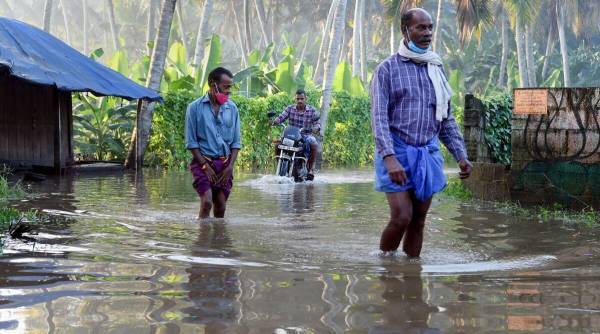Kerala: Three years and the ravages of climate change

Kerala: Three years and the ravages of climate change
On the morning of October 16 this year, when the pitters who were gently turned into heavy rain in a few minutes, Fouziya, 28, filmed two small children watching flood water up to their small home yard on the slopes of a hill. He sent a video to relative on WhatsApp. Some time later, when the rain did not show signs of relenting, Fouziya, now anxious, contacting relatives to convey their fears. Midway into the conversation, a hard roar was heard, the sound of large stones, mud and water slid down the hill. A few seconds later, the call was cut off when the house was broken and swept away, killing Fouziya, two of his children Ameen (10) and Amna (7), and children from his brother, Afiyan (4). When rescue workers dug debris, the remnants of two children were found as if they had embraced towards the end.
“It’s a sight that we will never forget. When we take corpses, we feel a big pain,” said a rescue worker to a local television channel.
Landslides in Poovanchi in Kokkay Panchayat from the Idukki District, who claimed seven lives including five Fouziya families, were the latest in Kerala trials with natural disasters born of extreme weather events. On the same day, only four kilometers on the other side of the same hill, the same landslide in Kotottickal Panchayat from Kottayam district killed 12, including six family members. A total of 42 people lost their lives between October 12 and October 20, said the Chairman of the Pinarayaya Minister Vijayan in the Assembly, because the country was hit by a very heavy rainfall explosion.
The Indian Meteorology Department (IMD), in the bulletin, connects the rain for the formation of a low pressure area in the Arabian sea and fresh spells of ‘Eastern Waves’. Although, for his credit, it did put several districts in the Orange Alert code ahead of October 16 warnings ‘isolated severe to very heavy rainfall’, but it was a fast turn in the volume of rainfall, especially locally, in districts such as Kottayam, Idukki and Pathanamthitta Some of the worst affected, raises questions about agency capabilities to make accurate micro level predictions. Consequently seen: during the day on October 16, several Central Kerala regencies were increased to red alert, pushing authority to take mass evacuation, open a help camp and lift the dam window to empty excess water. At that time, some small and large landslides have occurred in the hills and all cities such as Kanjirappally and Mundakayam are under water.
For those who live in river margins and rivers and on a hill and slopes in Kerala, whose daily routines are accompanied by nature, the sequence of events played last week is very familiar. In 2018, the country was hit by the worst floods in a century, killing more than 480 people and caused property damage in the tone of ₹ 4 lakh crore. The following year, two large landslides in Puthumala in Wayanad and Kavalappara Regency in Malappuram Regency in West Ghats contributed most of the 120 deaths in the incident related to rain. And in August 2020, Pettimudi, a small settlement that developed in the Idukki district, was damaged by the worst landslides in Kerala’s history, killing 70 people. In short, the last three years have given birth to testimony in the pattern of extraordinary weather events, placing the country directly at the intersection of climate change, and leaving ecologists wondering: is Kerala, fragile, equipped with what hasn’t arrived?
‘Kerala no longer a safe haven’
Gradual heating from the Arabian sea and the increase in the incidence of the cyclone formation in it is an indicator, it shows. The key question, he said, is whether the state government has a political desire to work on the development agenda in harmony with the reality of current climate change. “The government is still not overcoming it. It is necessary to discuss with experts to prepare a long-term solution. But everything that is discussed is compensation (for victims after a disaster),” he said.
Dr. Salom Gnana Thanga V, Head of the Department of Environmental Sciences at Kerala University, added, “We are not serious about (applying) a powerful solution. While designing a short-term or long-term development project, there must be components (climate friendly).” He called for Larger scientific involvement in development schemes and encouragement to ensure a good drainage system. “Follow the natural road,” his advice.





